A Bayesian Nonlinear Reduced Order Modeling Using Variational AutoEncoders
Abstract
1. Introduction
2. Some General Notations and Concepts
- u is an observable function;
- is the evidence of the function u or its marginal likelihood;
- is a random multi-dimensional variable or a latent unobservable variable depending on u. The dimension of depends on the characteristics and the features of the function u;
- is a given prior probability of the unobservable variable before any value of the function u is observed;
- is a Gaussian probability distribution based on which we may compute a logarithm-likelihood cost function in order to compute an output function that resembles at most the observable function u;
- is the posterior or the true probability of the unobservable random variable given the observed evidence.
3. Bayesian Inference
3.1. The Empirical Bayesian Method
3.2. The Variational Bayesian Method
4. Nonlinear Data Compression by Variational Autoencoders
- , where and are respectively the parametrized mean and logarithm of variance of the random latent variable , and is a random sample of a standard multivariate normal distribution of dimension n.
- This formulation is usually considered during the training of the VAE as it allows the backward differentiation of the deep neural network only on deterministic quantities that depend on the parameters of the encoder. The coordinates of z are independent and identically distributed following a standard normal distribution. This latter formulation is what is usually called the reparametrization trick.
- The Kullback–Leibler divergence used is the relative entropy between multivariate normal and standard normal distribution. The latent cost function in VAEs is given by [40]:
5. Formulation of the Bayesian Nonlinear Reduced Order Modeling for the Unsteady and Incompressible Navier–Stokes Equations Based on the Chorin Projection Method
5.1. Recall of the Chorin Projection Technique
5.2. Framework of the Bayesian Nonlinear Reduced Order Modeling
Our Proposed Algorithm
- Sample from the latent posterior distribution given the velocity at time instant advanced with the momentum equations without the pressure gradient term and decode the sampled random variable using g in order to obtain a sample of the intermediate velocity field as follows:
- Compute the pressure field at time instant following the Poisson Equation (6) with Neumann boundary conditions:with
- Perform the following consistency requirement that will be useful afterwards:In other words, we simply compress the pressure field at time instant in the reduced manifold given by the decoder mapping g.
- Sample from the latent posterior distribution given the intermediate velocity at time instant corrected with the projection equation and decode the sampled random variable using g in order to obtain a sample of the velocity field at time instant as follows:
- Perform the above four steps at each time instant until the end of the solution time duration.
- Repeat the above step for the desired number of samples for the incompressible and unsteady solution of the Navier–Stokes equations.
- Aggregate the ensemble of the unsteady solutions obtained from the previous step: compute statistics of this ensemble such as the mean and the standard deviation.
- Compute a confidence interval of the ROM mean prediction for each time instant.
5.3. Consistency of the Approximation
6. Numerical Experiments
6.1. Flow Solver
6.2. Application to a 2D Karman Vortex Street Flow
6.2.1. Training Phase of the VAE
6.2.2. POD for the Linear Reduced Order Modeling
6.2.3. Comparison between the Nonlinear Bayesian ROM and the POD-Galerkin ROM
6.2.4. Results for Mesh n°1
6.2.5. Results for Mesh n°2
6.2.6. Results for Mesh n°3
6.2.7. Discussion
- We showed the sharpness of the confidence interval of the ROM mean prediction with respect to the high-fidelity solution for relatively coarse structured grids of size and . The length of this confidence interval is defined by three times the standard deviation of the solution samples.
- We showed that, for a very coarse structured mesh, which is typically of size , the confidence interval of the ROM mean prediction of a length three times the standard deviation of the solution samples could not account for the high-fidelity solution with respect to time. This means that the high-fidelity solution was outside the confidence interval sometimes. This limitation is related to the adaptive time step in the Chorin time-explicit numerical scheme, which became important for the case of mesh n°3. This time step is around s, whereas it was around s and s, respectively, for mesh n°1 and mesh n°2. The time advance of the velocity field was biased by the large time step in the mesh n°3 case. This deviation with respect to the high-fidelity solution is not taken into account within the random latent space of the VAE because the neural network learned the high-fidelity solutions (obtained with a very small adaptive time step from the Yales2 solver around s) projected on coarse structured grids.
6.3. Application to a 3D Flow in an Aeronautical Injection System
6.3.1. Training Phase of the VAE
6.3.2. Results
7. Conclusions
Author Contributions
Funding
Data Availability Statement
Conflicts of Interest
References
- Swischuk, R.; Mainini, L.; Peherstorfer, B.; Willcox, K. Projection-based model reduction: Formulations for physics-based machine learning. Comput. Fluids 2019, 179, 704–717. [Google Scholar] [CrossRef]
- Ghattas, O.; Willcox, K. Learning physics-based models from data: Perspectives from inverse problems and model reduction. Acta Numer. 2021, 30, 445–554. [Google Scholar] [CrossRef]
- Parish, E.J.; Rizzi, F. On the impact of dimensionally-consistent and physics-based inner products for POD-Galerkin and least-squares model reduction of compressible flows. arXiv 2022, arXiv:2203.16492. [Google Scholar] [CrossRef]
- Qian, E.; Kramer, B.; Peherstorfer, B.; Willcox, K. Lift & learn: Physics-informed machine learning for large-scale nonlinear dynamical systems. Phys. D Nonlinear Phenom. 2020, 406, 132401. [Google Scholar]
- Li, X.; Zhang, W. Physics-informed deep learning model in wind turbine response prediction. Renew. Energy 2022, 185, 932–944. [Google Scholar] [CrossRef]
- Zhang, R.; Liu, Y.; Sun, H. Physics-informed multi-LSTM networks for metamodeling of nonlinear structures. Comput. Methods Appl. Mech. Eng. 2020, 369, 113226. [Google Scholar] [CrossRef]
- Akkari, N.; Casenave, F.; Daniel, T.; Ryckelynck, D. Data-Targeted Prior Distribution for Variational AutoEncoder. Fluids 2021, 6, 343. [Google Scholar] [CrossRef]
- Salvador, M.; Dede, L.; Manzoni, A. Non intrusive reduced order modeling of parametrized PDEs by kernel POD and neural networks. Comput. Math. Appl. 2021, 104, 1–13. [Google Scholar] [CrossRef]
- Kwok, J.T.; Tsang, I.W. The pre-image problem in kernel methods. IEEE Trans. Neural Netw. 2004, 15, 1517–1525. [Google Scholar] [CrossRef]
- Holmes, P.; Lumley, J.; Berkooz, G.; Rowley, C. Turbulence, Coherent Structures, Dynamical Systems and Symmetry, 2nd ed.; Cambridge University Press: Cambridge, UK, 2012; pp. 358–377. [Google Scholar]
- Sirovich, L. Turbulence and the dynamics of coherent structures. Part III Dyn. Scaling Q. Appl. Math. 1987, 45, 583–590. [Google Scholar] [CrossRef]
- Iollo, A.; Lanteri, S.; Désidéri, J.A. Stability properties of POD–Galerkin approximations for the compressible Navier–Stokes equations. Theor. Comput. Fluid Dyn. 2000, 13, 377–396. [Google Scholar] [CrossRef]
- Sirisup, S.; Karniadakis, G.E. A spectral viscosity method for correcting the long-term behavior of POD models. J. Comput. Phys. 2004, 194, 92–116. [Google Scholar] [CrossRef]
- Akkari, N.; Casenave, F.; Moureau, V. Time Stable Reduced Order Modeling by an Enhanced Reduced Order Basis of the Turbulent and Incompressible 3D Navier–Stokes Equations. Math. Comput. Appl. 2019, 24, 45. [Google Scholar] [CrossRef]
- Reyes, R.; Codina, R. Projection-based reduced order models for flow problems: A variational multiscale approach. Comput. Methods Appl. Mech. Eng. 2020, 363, 112844. [Google Scholar] [CrossRef]
- Akkari, N.; Hamdouni, A.; Erwan, L.; Jazar, M. On the sensitivity of the POD technique for a parameterized quasi-nonlinear parabolic equation. Adv. Model. Simul. Eng. Sci. 2014, 1, 14. [Google Scholar] [CrossRef]
- Grimberg, S.; Farhat, C.; Youkilis, N. On the stability of projection-based model order reduction for convection-dominated laminar and turbulent flows. J. Comput. Phys. 2020, 419, 109681. [Google Scholar] [CrossRef]
- Noack, B.R.; Papas, P.; Monkewitz, P.A. The need for a pressure-term representation in empirical Galerkin models of incompressible shear flows. J. Fluid Mech. 2005, 523, 339–365. [Google Scholar] [CrossRef]
- Stabile, G.; Rozza, G. Finite volume POD-Galerkin stabilised reduced order methods for the parametrised incompressible Navier–Stokes equations. Comput. Fluids 2018, 173, 273–284. [Google Scholar] [CrossRef]
- Baiges, J.; Codina, R.; Idelsohn, S. Reduced-order subscales for POD models. Comput. Methods Appl. Mech. Eng. 2015, 291, 173–196. [Google Scholar] [CrossRef]
- Guo, M.; McQuarrie, S.A.; Willcox, K.E. Bayesian operator inference for data-driven reduced-order modeling. arXiv 2022, arXiv:2204.10829. [Google Scholar] [CrossRef]
- Goodfellow, I.; Bengio, Y.; Courville, A. Deep Learning; MIT Press: Cambridge, MA, USA, 2016; Available online: http://www.deeplearningbook.org (accessed on 1 September 2022).
- Kashima, K. Nonlinear model reduction by deep autoencoder of noise response data. In Proceedings of the 2016 IEEE 55th Conference on Decision and Control (CDC), Las Vegas, NV, USA, 12–14 December 2016; pp. 5750–5755. [Google Scholar] [CrossRef]
- Hartman, D.; Mestha, L.K. A deep learning framework for model reduction of dynamical systems. In Proceedings of the 2017 IEEE Conference on Control Technology and Applications (CCTA), Maui, HI, USA, 27–30 August 2017; pp. 1917–1922. [Google Scholar] [CrossRef]
- Lee, K.; Carlberg, K. Model reduction of dynamical systems on nonlinear manifolds using deep convolutional autoencoders. J. Comput. Phys. 2020, 404, 108973. [Google Scholar] [CrossRef]
- Kingma, D.P.; Welling, M. Auto-Encoding Variational Bayes. arXiv 2013, arXiv:1312.6114. [Google Scholar] [CrossRef]
- Chorin, A.J.; Marsden, J.E.; Marsden, J.E. A Mathematical Introduction to Fluid Mechanics; Springer Science+Business Media: New York, NY, USA, 1990; Volume 3. [Google Scholar]
- Fauque, J.; Ramière, I.; Ryckelynck, D. Hybrid hyper-reduced modeling for contact mechanics problems. Int. J. Numer. Methods Eng. 2018, 115, 117–139. [Google Scholar] [CrossRef]
- Santo, N.D.; Manzoni, A. Hyper-reduced order models for parametrized unsteady Navier–Stokes equations on domains with variable shape. Adv. Comput. Math. 2019, 45, 2463–2501. [Google Scholar] [CrossRef]
- Ryckelynck, D.; Lampoh, K.; Quilicy, S. Hyper-reduced predictions for lifetime assessment of elasto-plastic structures. Meccanica 2016, 51, 309–317. [Google Scholar] [CrossRef]
- Amsallem, D.; Zahr, M.J.; Farhat, C. Nonlinear model order reduction based on local reduced-order bases. Int. J. Numer. Methods Eng. 2012, 92, 891–916. [Google Scholar] [CrossRef]
- Mignolet, M.P.; Soize, C. Stochastic reduced order models for uncertain geometrically nonlinear dynamical systems. Comput. Methods Appl. Mech. Eng. 2008, 197, 3951–3963. [Google Scholar] [CrossRef]
- Partaourides, H.; Chatzis, S.P. Asymmetric deep generative models. Neurocomputing 2017, 241, 90–96. [Google Scholar] [CrossRef]
- Rezende, D.J.; Mohamed, S. Variational Inference with Normalizing Flows. In Proceedings of the 32nd International Conference on Machine Learning, Lille, France, 6–11 July 2015. [Google Scholar] [CrossRef]
- Caterini, A.L.; Doucet, A.; Sejdinovic, D. Hamiltonian Variational Auto-Encoder. arXiv 2018. [Google Scholar] [CrossRef]
- Joyce, J. Bayes’ Theorem. In The Stanford Encyclopedia of Philosophy, Fall 2021 ed.; Zalta, E.N., Ed.; Metaphysics Research Lab, Stanford University: Stanford, CA, USA, 2021. [Google Scholar]
- Casella, G. An Introduction to Empirical Bayes Data Analysis. Am. Stat. 1985, 39, 83–87. [Google Scholar]
- Blei, D.M.; Kucukelbir, A.; McAuliffe, J.D. Variational Inference: A Review for Statisticians. J. Am. Stat. Assoc. 2017, 112, 859–877. [Google Scholar] [CrossRef]
- Kullback, S. Information Theory and Statistics; Courier Corporation: North Chelmsford, MA, USA, 1997. [Google Scholar]
- Tran, V.H. Copula Variational Bayes inference via information geometry. arXiv 2018, arXiv:1803.10998. [Google Scholar] [CrossRef]
- Payne, L. Uniqueness and continuous dependence criteria for the Navier–Stokes equations. Rocky Mt. J. Math. 1972, 2, 641–660. [Google Scholar] [CrossRef]
- Moureau, V.; Domingo, P.; Vervisch, L. Design of a massively parallel CFD code for complex geometries. Comptes Rendus Mécanique 2011, 339, 141–148. [Google Scholar] [CrossRef]
- Moureau, V.; Domingo, P.; Vervisch, L. From Large-Eddy Simulation to Direct Numerical Simulation of a lean premixed swirl flame: Filtered laminar flame-PDF modeling. Combust. Flame 2011, 158, 1340–1357. [Google Scholar] [CrossRef]
- Malandain, M.; Maheu, N.; Moureau, V. Optimization of the deflated conjugate gradient algorithm for the solving of elliptic equations on massively parallel machines. J. Comput. Phys. 2013, 238, 32–47. [Google Scholar] [CrossRef]
- Nicolaides, R.A. Deflation of conjugate gradients with applications to boundary value problems. SIAM J. Numer. Anal. 1987, 24, 355–365. [Google Scholar] [CrossRef]
- Kingma, D.P.; Ba, J. Adam: A Method for Stochastic Optimization. arXiv 2014, arXiv:1412.6980. [Google Scholar] [CrossRef]
- Bergmann, M.; Cordier, L. Contrôle optimal par réduction de modèle POD et méthode à région de confiance du sillage laminaire d’un cylindre circulaire. Mech. Ind. 2007, 8, 111–118. [Google Scholar] [CrossRef]
- Lourier, J.M.; Stöhr, M.; Noll, B.; Werner, S.; Fiolitakis, A. Scale Adaptive Simulation of a thermoacoustic instability in a partially premixed lean swirl combustor. Combust. Flame 2017, 183, 343–357. [Google Scholar] [CrossRef]
- Franzelli, B.; Riber, E.; Gicquel, L.Y.; Poinsot, T. Large Eddy Simulation of combustion instabilities in a lean partially premixed swirled flame. Combust. Flame 2012, 159, 621–637. [Google Scholar] [CrossRef]
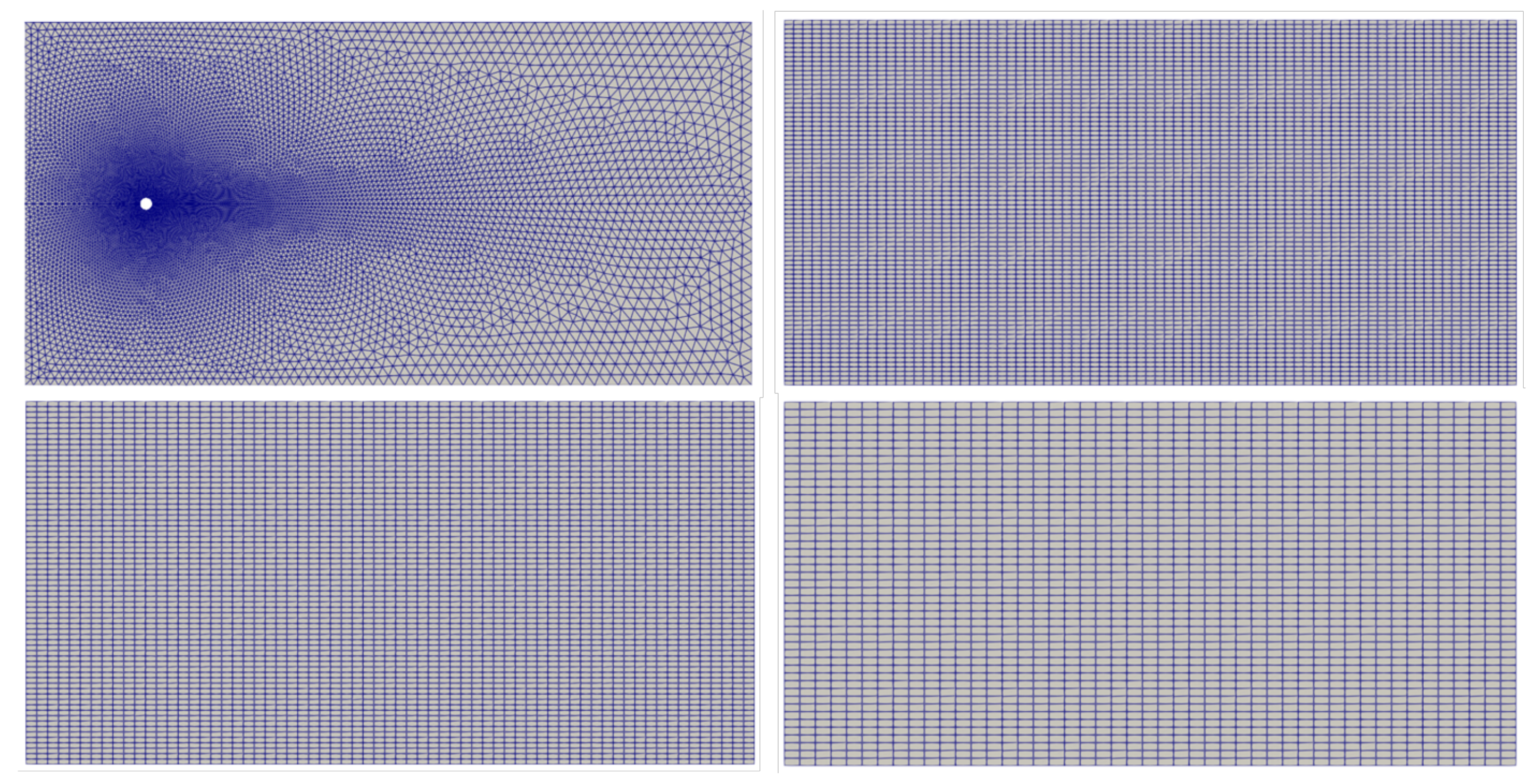



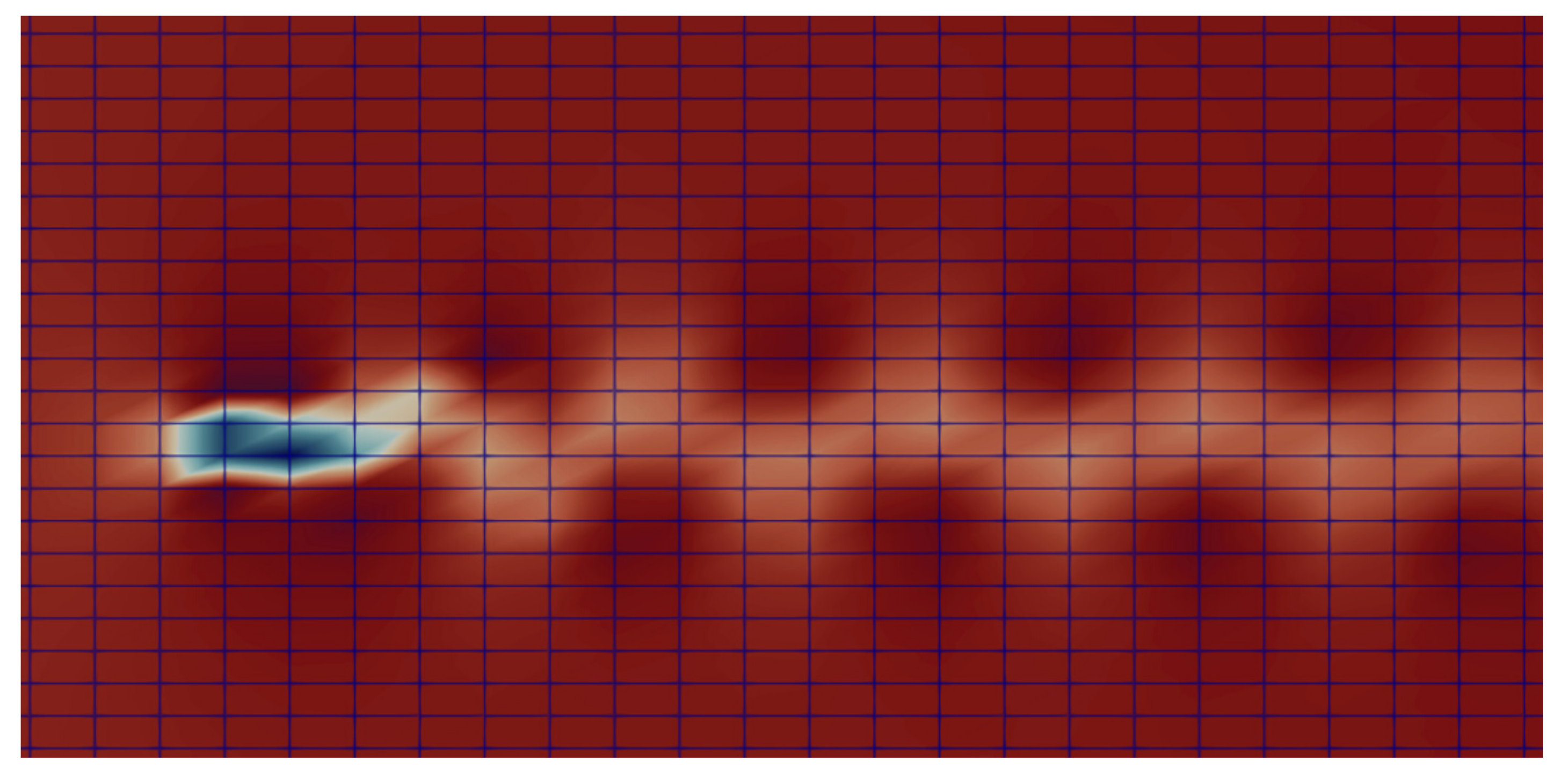


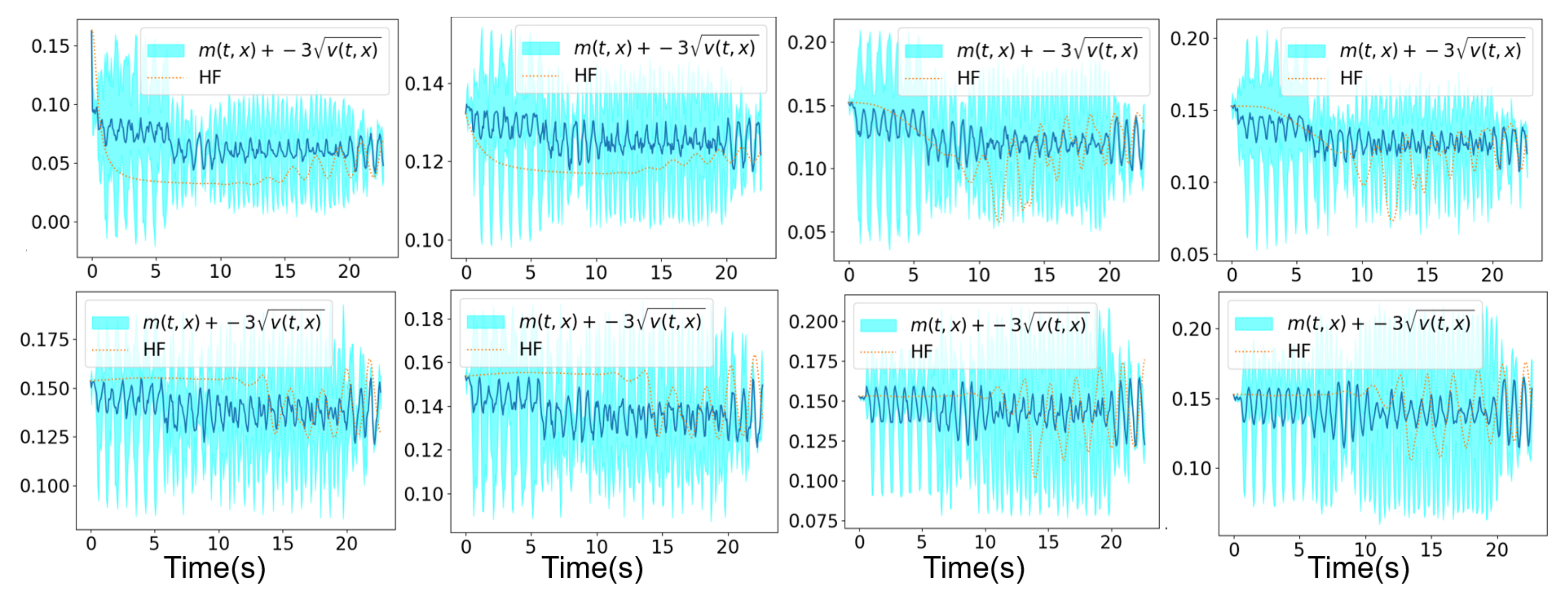


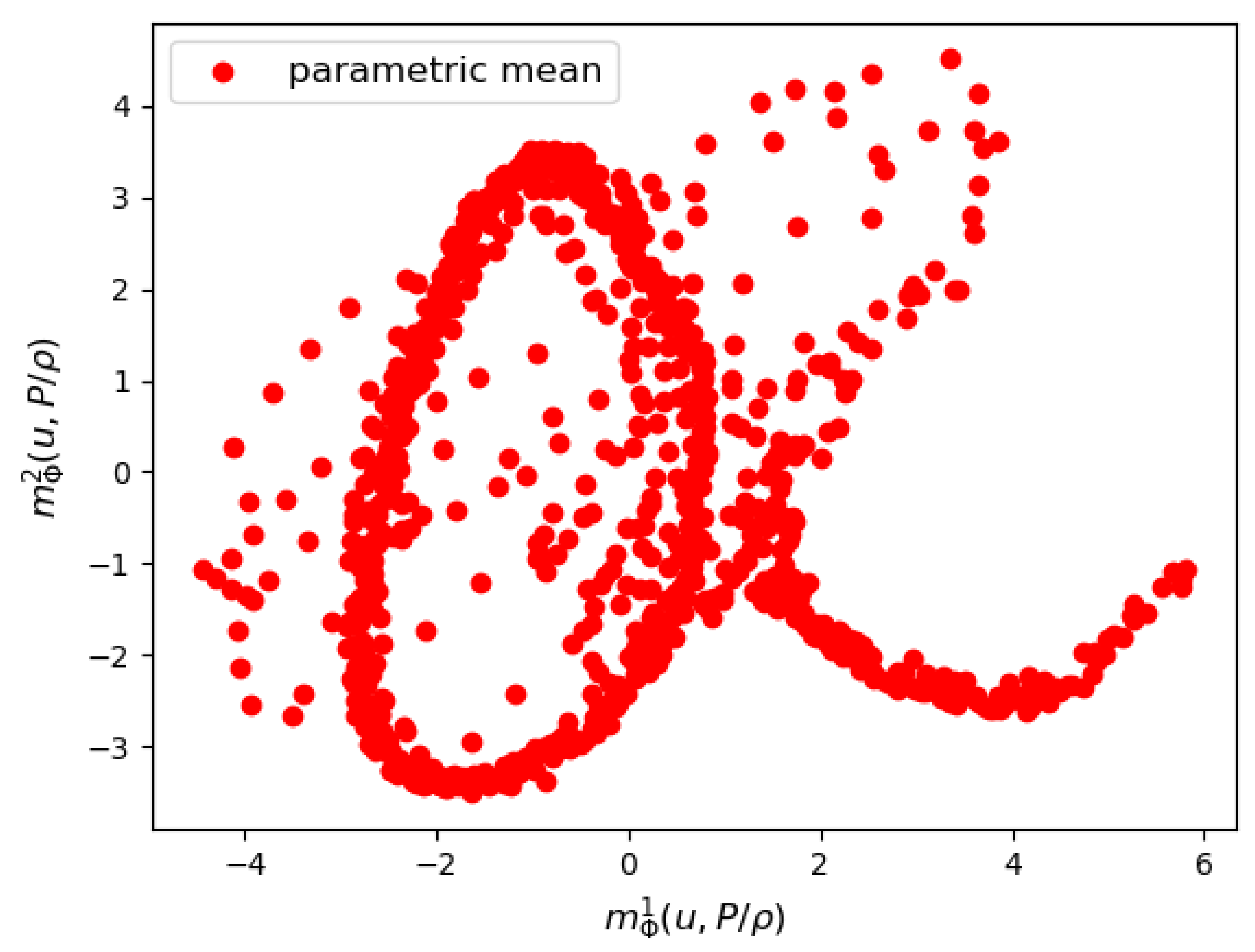
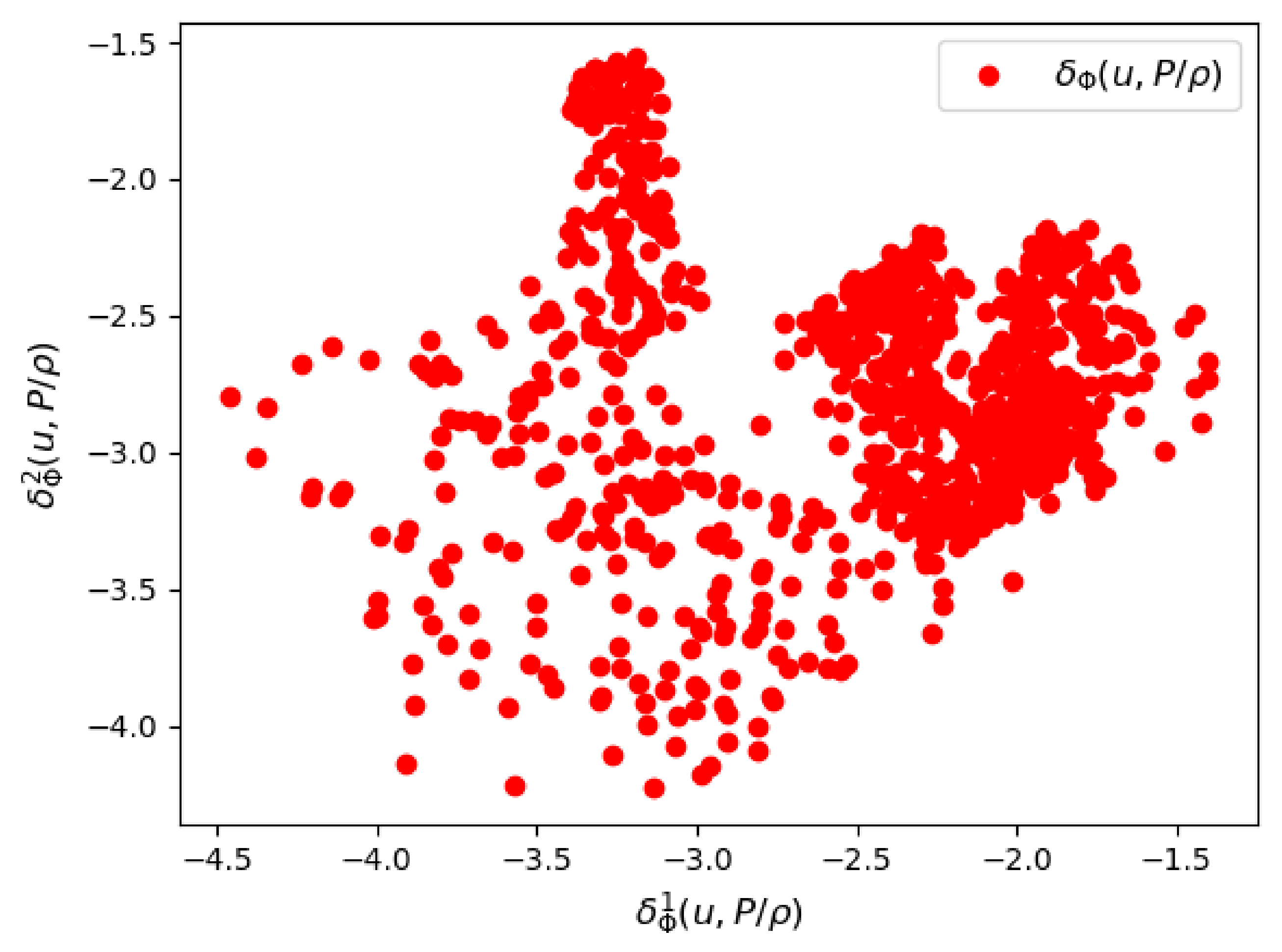
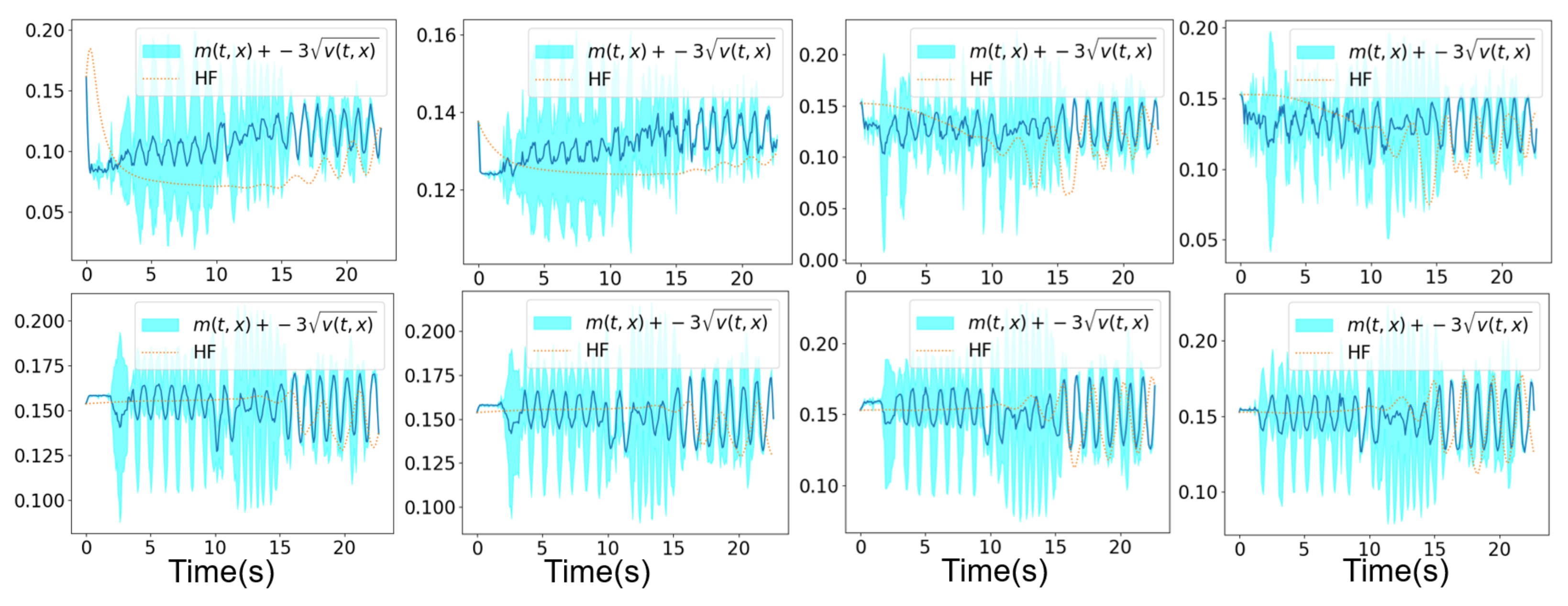

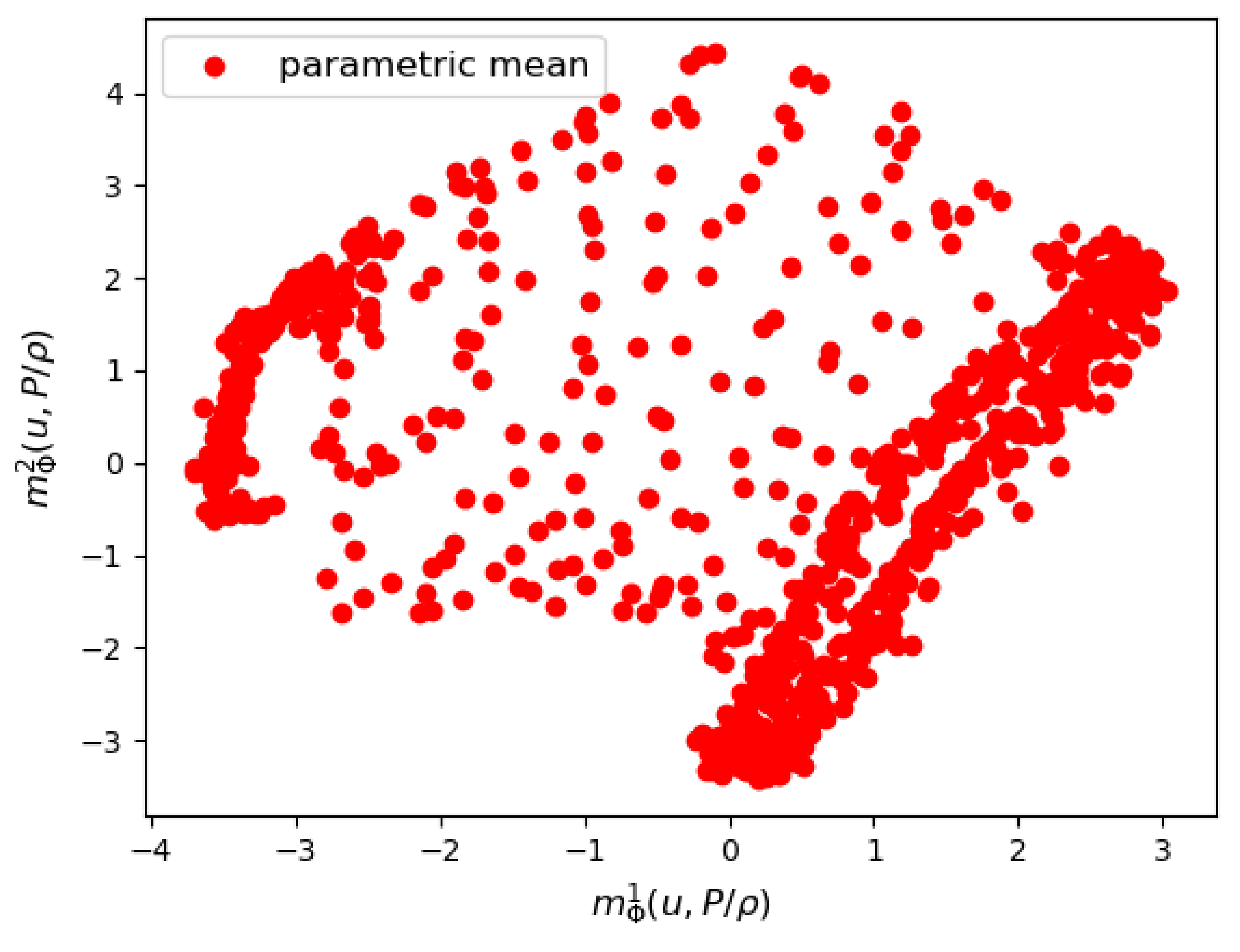
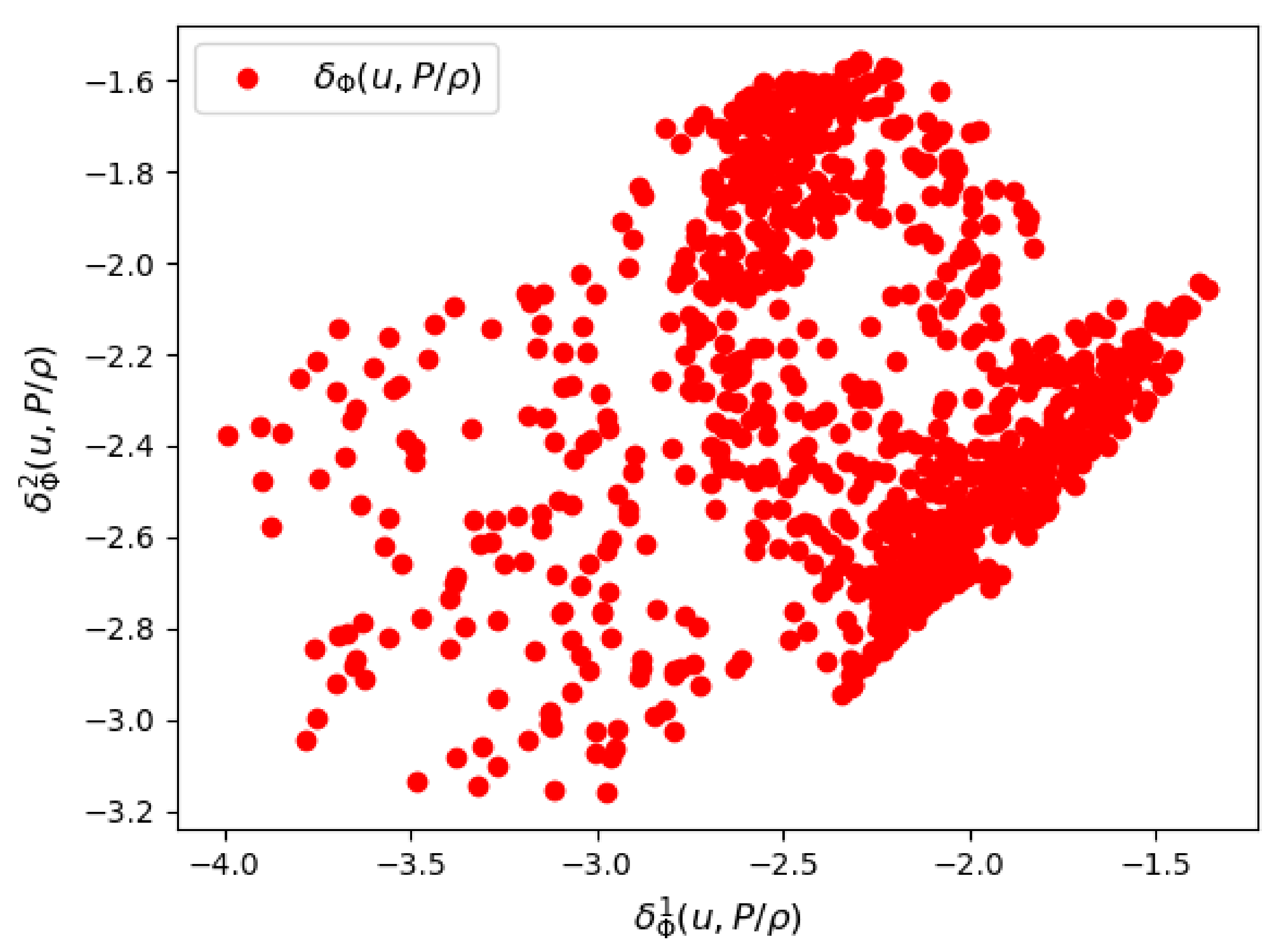
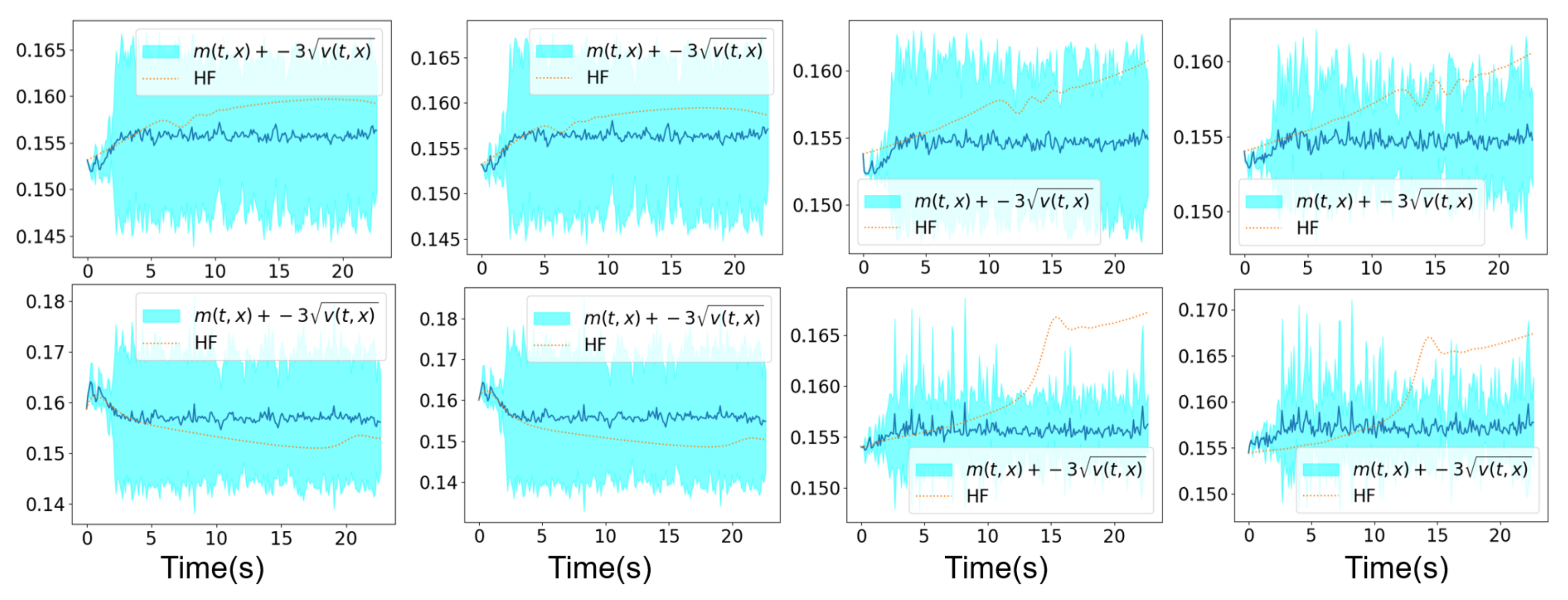


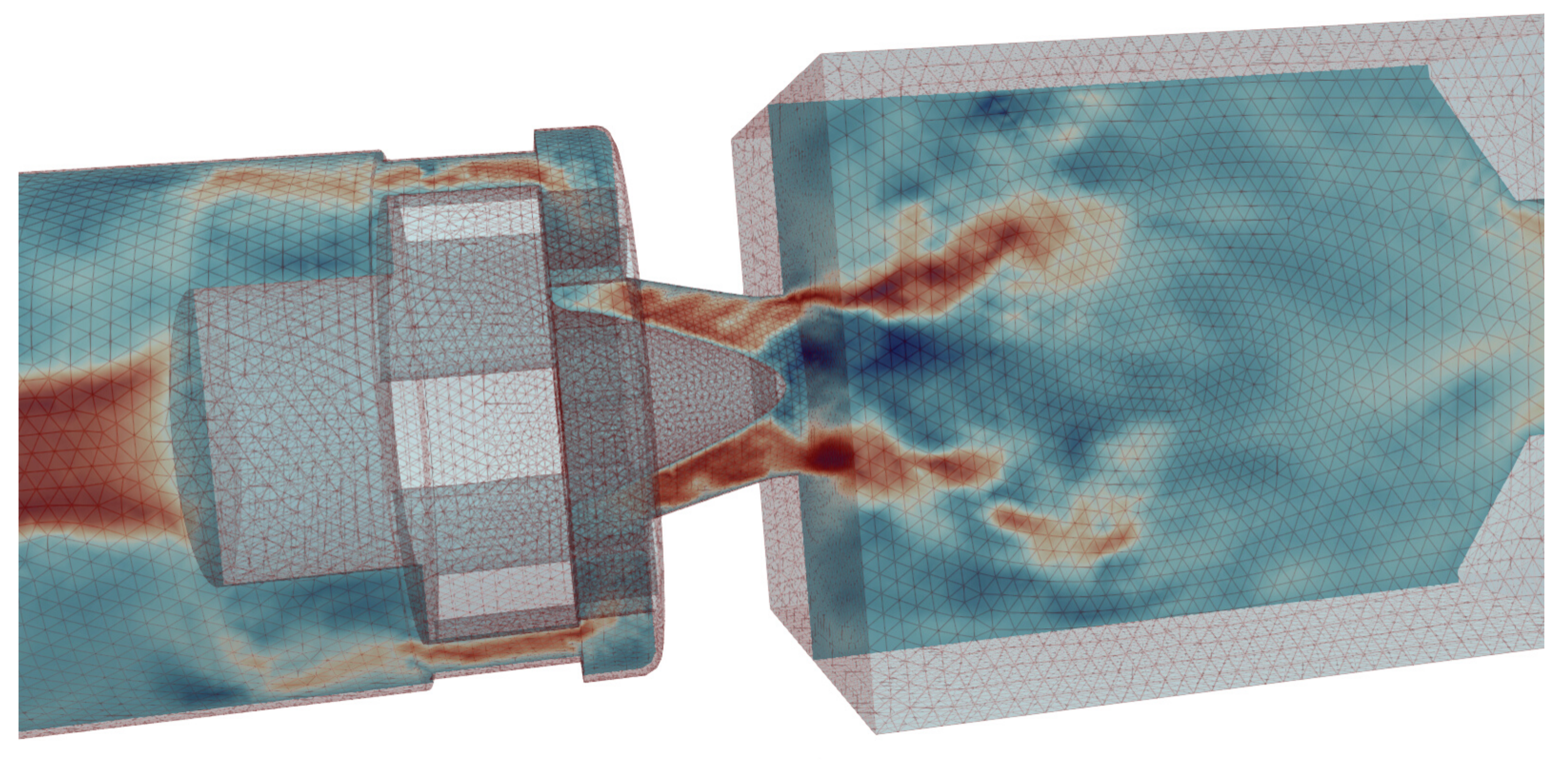
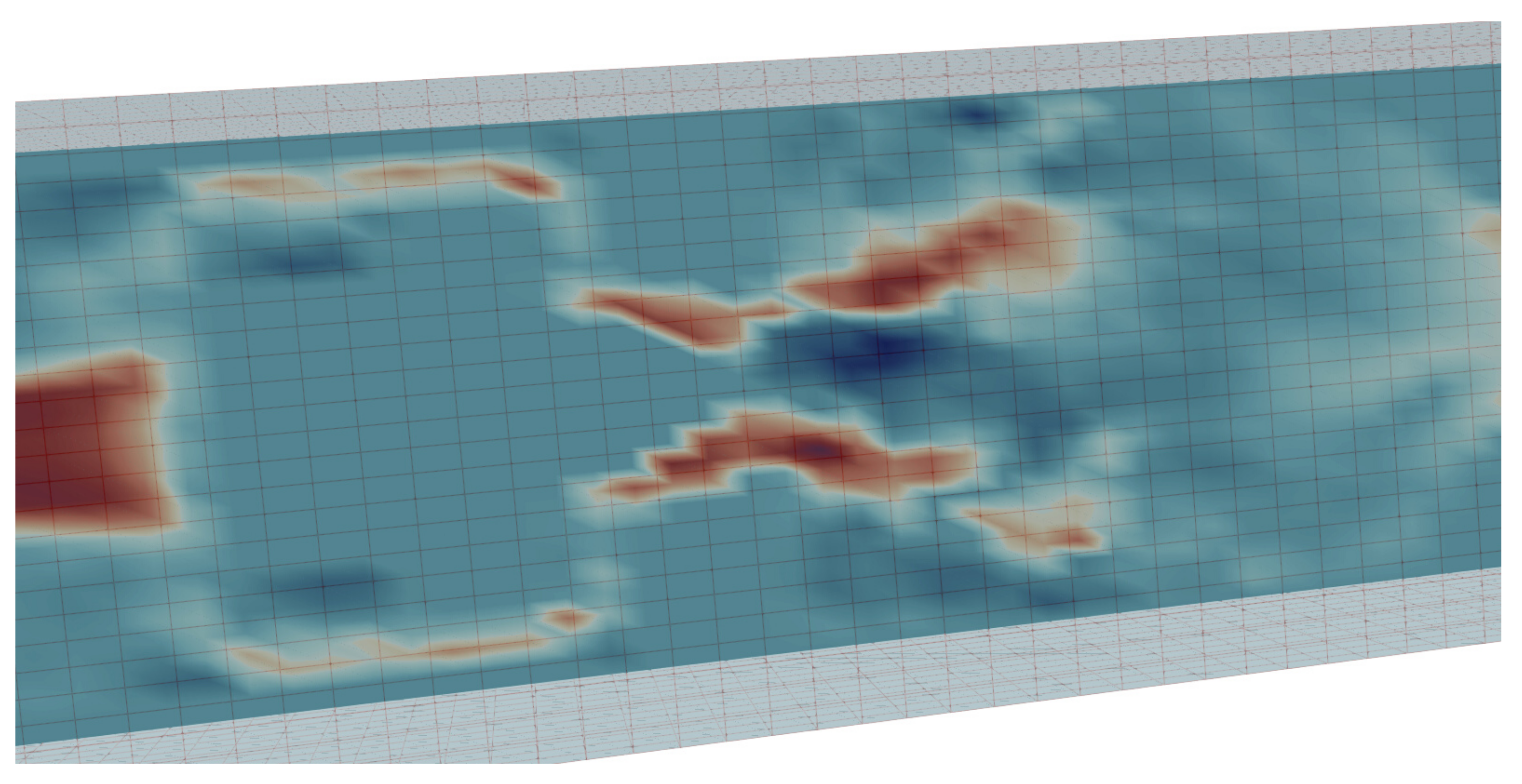
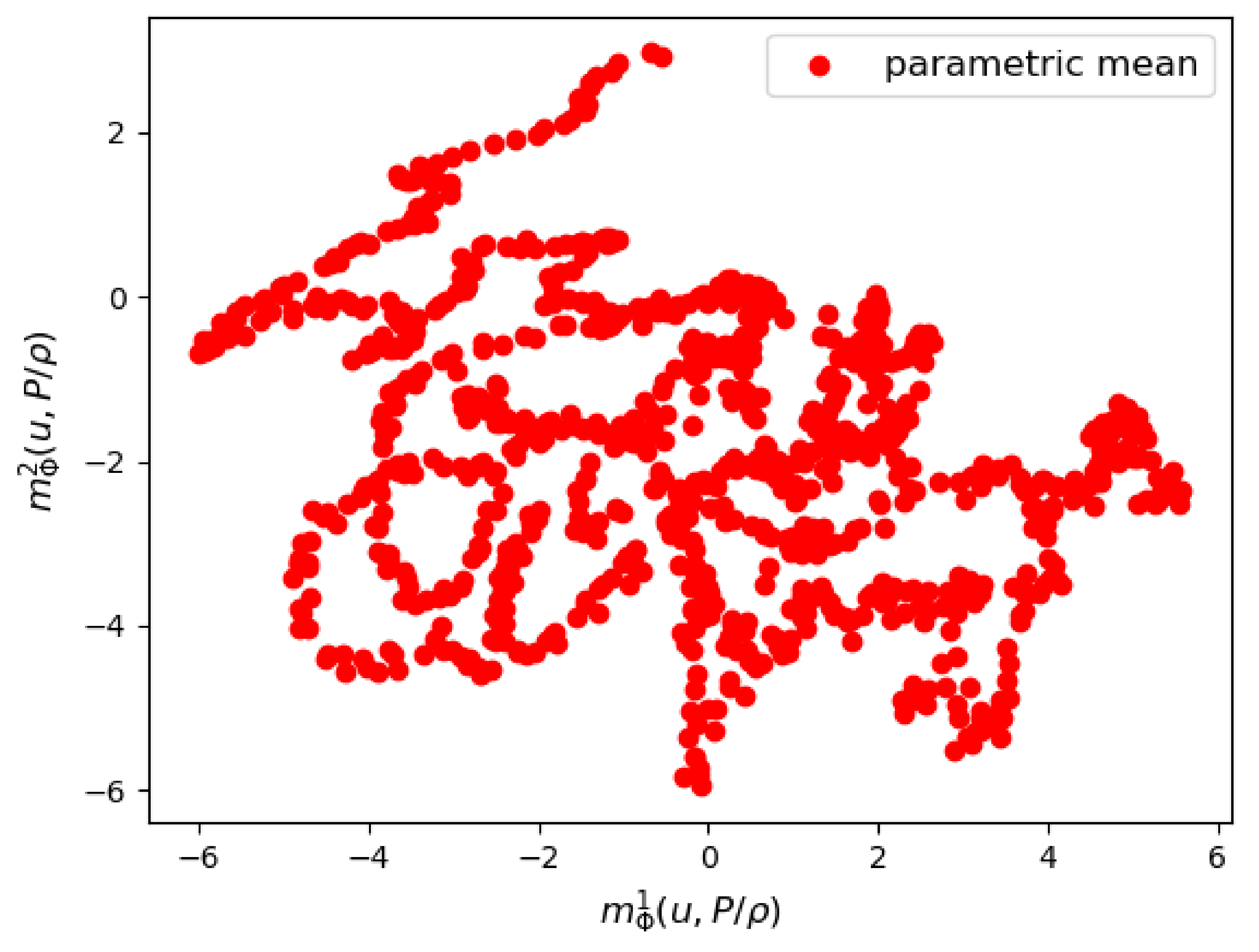
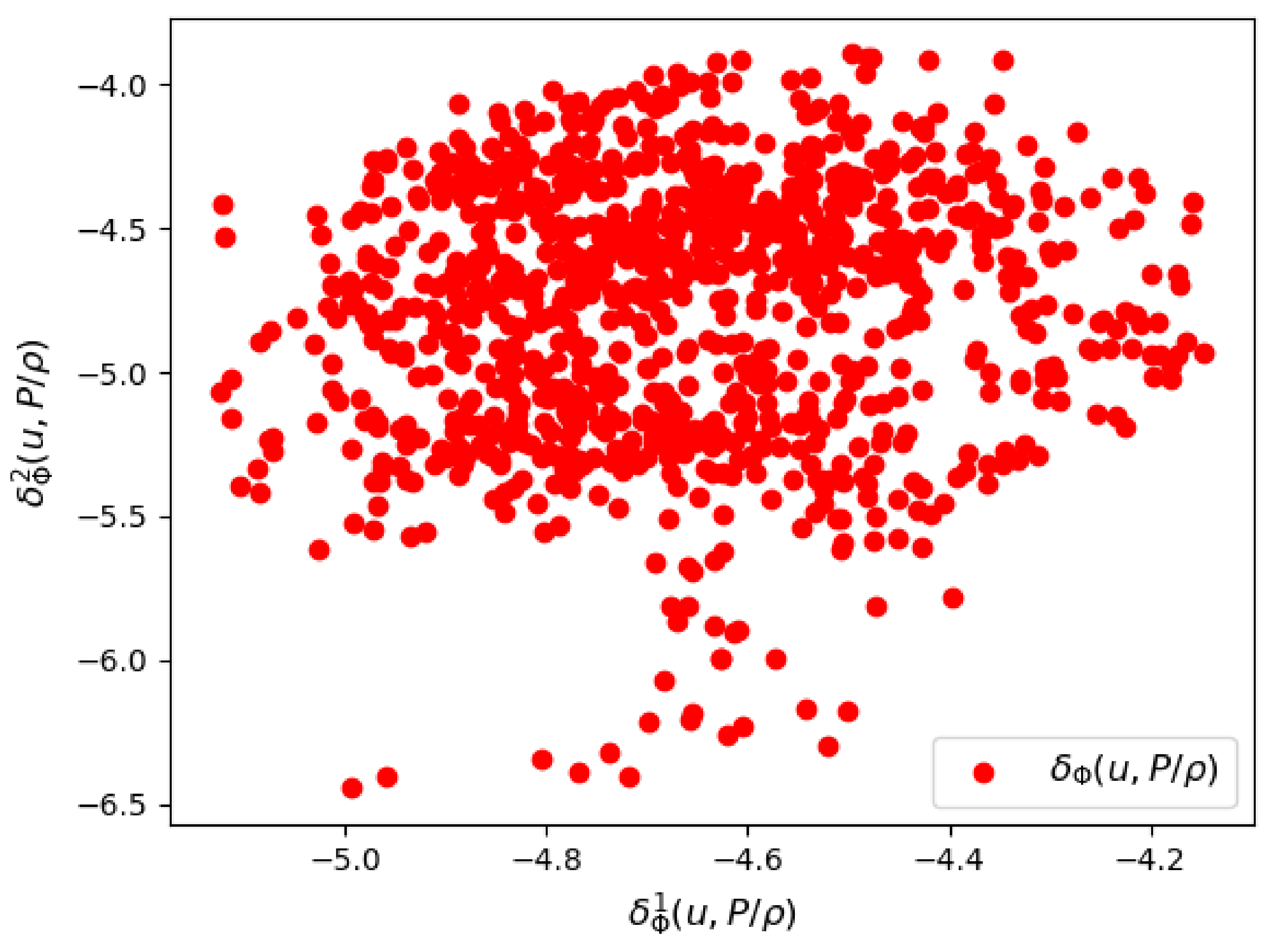

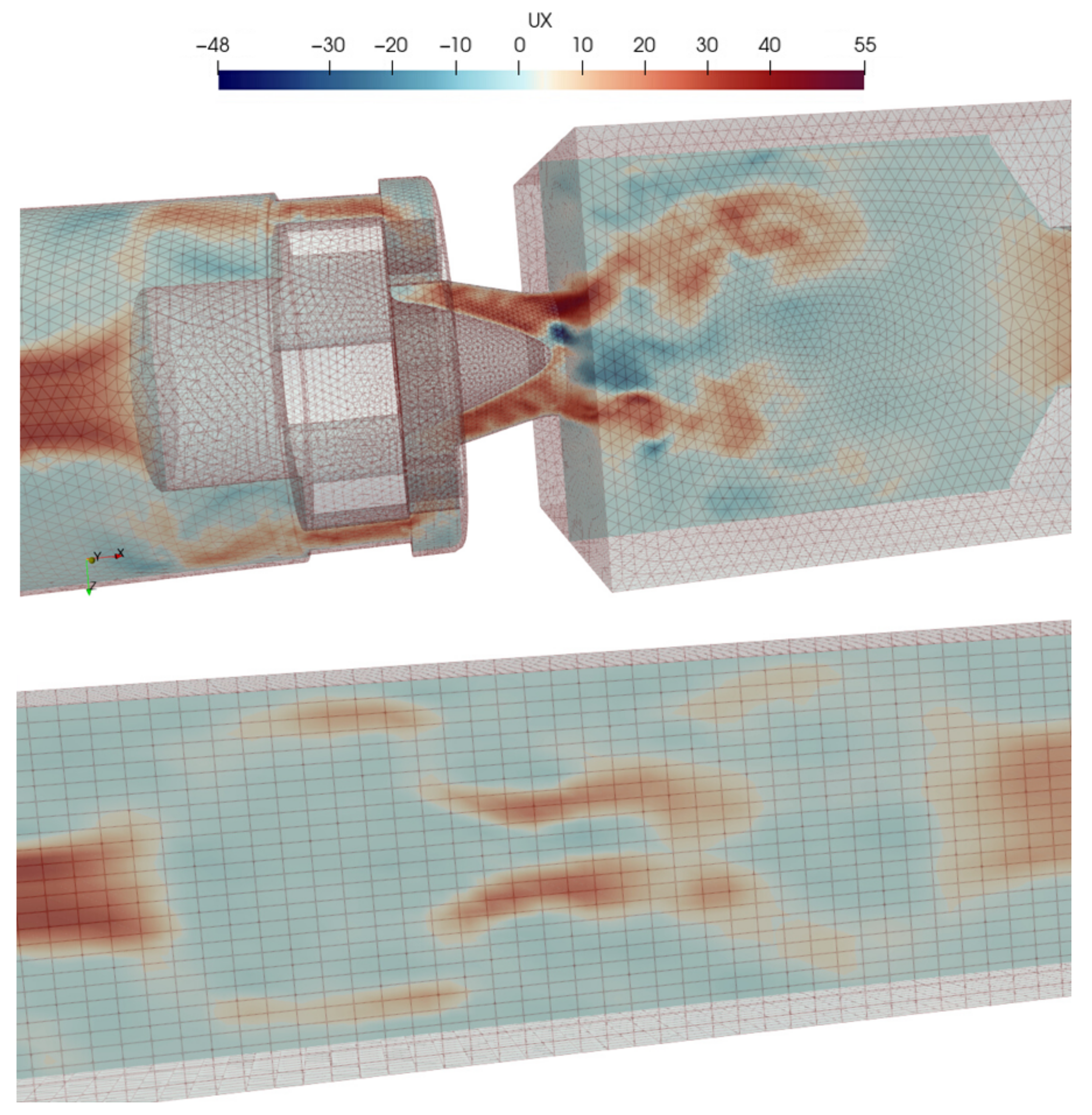
| Mesh n°1 | Mesh n°2 | Mesh n°3 |
|---|---|---|
| Cartesian of size | Cartesian of size | Cartesian of size |
Publisher’s Note: MDPI stays neutral with regard to jurisdictional claims in published maps and institutional affiliations. |
© 2022 by the authors. Licensee MDPI, Basel, Switzerland. This article is an open access article distributed under the terms and conditions of the Creative Commons Attribution (CC BY) license (https://creativecommons.org/licenses/by/4.0/).
Share and Cite
Akkari, N.; Casenave, F.; Hachem, E.; Ryckelynck, D. A Bayesian Nonlinear Reduced Order Modeling Using Variational AutoEncoders. Fluids 2022, 7, 334. https://doi.org/10.3390/fluids7100334
Akkari N, Casenave F, Hachem E, Ryckelynck D. A Bayesian Nonlinear Reduced Order Modeling Using Variational AutoEncoders. Fluids. 2022; 7(10):334. https://doi.org/10.3390/fluids7100334
Chicago/Turabian StyleAkkari, Nissrine, Fabien Casenave, Elie Hachem, and David Ryckelynck. 2022. "A Bayesian Nonlinear Reduced Order Modeling Using Variational AutoEncoders" Fluids 7, no. 10: 334. https://doi.org/10.3390/fluids7100334
APA StyleAkkari, N., Casenave, F., Hachem, E., & Ryckelynck, D. (2022). A Bayesian Nonlinear Reduced Order Modeling Using Variational AutoEncoders. Fluids, 7(10), 334. https://doi.org/10.3390/fluids7100334







